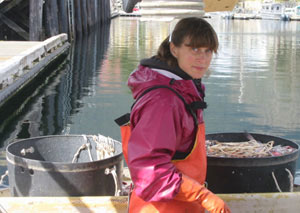
Voices From the Waterfront Meet Commercial Fisher Linda Behnken March 29, 2011
Why did you get into fishing? I came here because I wanted to see the wilds of Alaska and needed to earn some money for college. I very quickly fell in love with the community of fishermen and the family fisheries of southeast Alaska. In what ways have you seen commercial fishing change in the last 30 years? Probably the biggest change has been the switch from open access fisheries with sablefish and halibut to the individual fishing quota program, a catch share program that started in 1995. That had a huge effect on the fishery and the fishing. Tell us more about the positive and negative changes. The fisheries had evolved to derby style fisheries, or races for the fish, with fishing openings as short as 12 hours for halibut and a week for sablefish. People went regardless of the weather because we had to make our living. We fished in terrible weather and we all lost friends; we all had a lot of close calls. People set as much gear as they could and hauled it back as fast as they could. Then all the fish were brought into town at once and dumped on the processors. Product quality suffered from people having to work too fast on the water and from most of the product having to ship frozen instead of fresh - it affected our price. Since we’ve moved to the individual fishing quota program, people have eight months to catch their quota and can pick their weather. They can pick their spots to fish and stay away from other fishing gear. Our fresh market has increased dramatically. Prices have also risen in response to having good, fresh, high-quality fish on the market for a significant part of the year. It used to be that anyone who had a boat could go fishing and fill up their boat, whatever size their boat was. They held their head high in town - they were high-liners [those who landed the most fish] - and people respected them. Since 1995, you have to buy the quota if you didn’t receive an initial allocation. Quota share is very expensive. We have a lot of young people who don’t have a borrowing history and have little or no access to capital. In rural, coastal communities there are very few alternative sources of employment. The entry level is expensive, but for people who have good crew jobs and who can save up the money to purchase quota share, it is a great way to fish. What are the downsides to catch shares as you see it? It used to be that anyone who had a boat could go fishing and fill up their boat, whatever size their boat was. They held their head high in town — they were high-liners [those who landed the most fish] - and people respected them. Since 1995, you have to buy the quota if you didn’t receive an initial allocation. Quota share is very expensive. We have a lot of young people who don’t have a borrowing history and have little or no access to capital. In rural, coastal communities there are very few alternative sources of employment. The entry level is expensive, but for people who have good crew jobs and who can save up the money to purchase quota share, it is a great way to fish. We hear you are trying to help young people support themselves in commercial fishing. Tell us more. My organization, the Alaska Longline Fishermen’s Association (ALFA), has worked with the North Pacific Trust and, with support from the Oak, Surdna and Ford foundations, formed the Alaska Sustainable Fisheries Trust. We’re working to help young people buy quota share. It’s very tough right now. The prices are so high. We’re also trying to work with our members in ALFA who have significant holdings, so that when they get ready to sell [their share] they can think about keeping those shares in the community. Have the changes you’ve seen given you and your family new ideas about how to work in the waterfront community? The individual fishing quota program has opened up a lot of possibilities to market fish in more creative ways, to provide consumers with better product and help them be more connected to the people who catch their fish. Last year we started a community-supported fishery program called Alaskan’s Own. People sign up for a subscription and they receive fish from the boats participating in our Fishery Conservation Network every two weeks during the spring and summer. So we’ve got to ask: What’s your favorite fish? It would have to be black cod (another name for sablefish). I’ve never eaten anything better. It’s firm and has incredible flavor. We marinate it in a teriyaki sauce with ginger and garlic and barbeque it over a really hot fire.
Source of Voices From the Waterfront:
Publish A Letter in SitNews Read Letters/Opinions
|
|||
